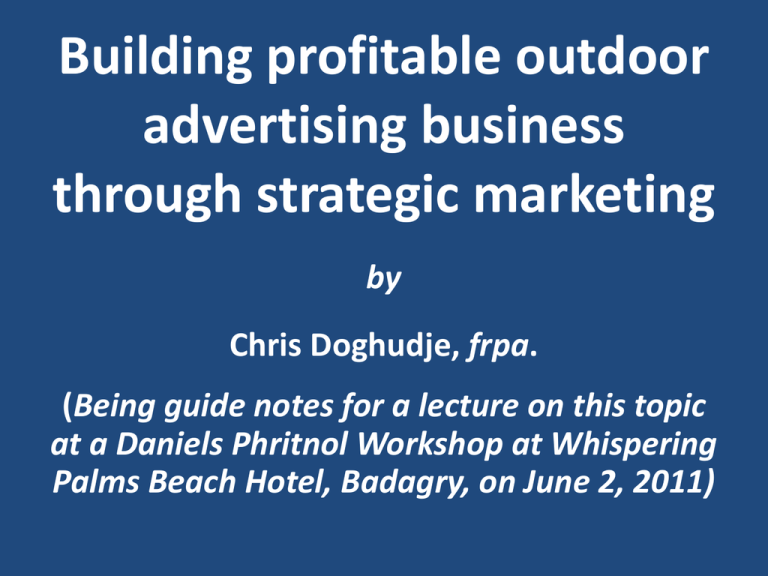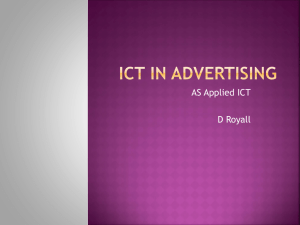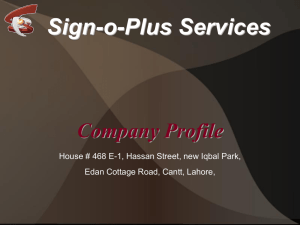Strategies For Developing And Deploying Market Intelligence For
advertisement

Building profitable outdoor advertising business through strategic marketing by Chris Doghudje, frpa. (Being guide notes for a lecture on this topic at a Daniels Phritnol Workshop at Whispering Palms Beach Hotel, Badagry, on June 2, 2011) 1. Starters 1.1. Quote “I will float like a butterfly and sting like a bee.” This is a remarkable strategy statement that came from no less a world personality than Mohammed Ali, when the legendary boxer was to fight Sonny Liston, otherwise known as the bull, quite a while ago. If you agree that that was a great strategy by a great man, then half of the task of this lecture has been done because we have strategies in all fields of human endeavour – military, boxing, politics, football, love, religion, business, marketing and advertising. 1.2. Meanings or perceptions The title of this lecture has words that may mean different things to different people, depending on the pictures in their heads. To streamline these meanings or perceptions. I am going to attempt to define some of the words or phrases. * “Building” in the context of this lecture should be seen as (i) creating or (ii) gradually adding to something as in “the building of muscles.” Meanings or perceptions Contd. * “Profitable” stands for “gainful.” In business it describes a situation in which income is higher than expenditure. If a business is not profitable, it cannot be sustained and it cannot grow. * “Outdoor Advertising” stands for what is now generally known as outof-home (OOH) advertising. And that is advertising on billboards, buses, taxis, lampposts, etc, etc. Meanings or perceptions Contd. *“Business” is an intriguing word which stands for “enterprise” or “a commercial activity,” but which today has been basterdised to mean virtually any occupation. It is not unusual these days for politicians, preachers, hawkers and even prostitutes to claim to be businessmen or women. (An aside: I remember a top politician from one of the South Eastern states claiming that politics in the East is business and another man from the same Eastern states claiming that politics is an investment. To make you laugh a bit, how about a prostitute arrested by a police for wandering who claimed she was in the business of building and demolishing erections! Ladies and gentlemen, let’s see business as a commercial activity engaged in so as to make a profit or as a means of livelihood. Meanings or perceptions Contd. *“Strategy” simply means “a plan of action.” It originated as a military term which stands for “a plan as to how to deploy troops so as to gain maximum advantage over the enemy.” Note that “strategy” is different from “execution;” strategy comes before execution – yes, the former is a statement of intention to act in a certain way, while the latter is the action itself. *“Execution” must be based on a “strategy,” not the other way round. A good strategy ensures success, not only in the business of marketing, but also in politics, football and boxing. Meanings or perceptions Contd. *“Marketing,” as described by economists, is the exchange of value for money, while those of us who want to differentiate it from trading see marketing as “a business process of identifying, anticipating and satisfying customer requirements at a profit in the long term.” These days, it is not uncommon for marketing writers to describe marketing as value creation, value delivery and value promotion. We should not forget what Prof. Theodore Levitt, a former editor of Harvard Business Review, says about marketing. According to him, “marketing is where the customer is for, in the end, it is the customer that decides the fate of every business” Meanings or perceptions Contd. Nor should we forget how the famous marketing guru, Philip Kotler, defines marketing lately as “the art of finding, developing and profiting from opportunities.” * Now, what am I going to talk about? It is “creating a gainful out-of-home advertising enterprise through planned customer satisfaction.” Simply put, it is “planning for success in outdoor advertising.” And my task henceforth is to highlight some approaches/concepts/strategies that can lead to success in the outdoor advertising business. 2.Marketing approaches/concepts/strategies. There may be no less than a hundred strategies at the moment just as there are no less than one hundred outdoor advertising formats. But I want to restrict myself to only twelve strategies to serve as an appetizer in your quest for profitable strategies for going about the business of outdoor advertising. WARNING: There is considerable overlap among the strategies; some are really two or three strategies combined. 2.1. Product strategy The emphasis in this strategy is on quality of product. You go into the outdoor business ensuring that your billboards or other outdoor formats are of the best quality, strategically positioned and premium-priced. You are the Roll Royce or Omega of outdoor. You have a few sites, but they are beautifully produced, beautifully sited and beautifully maintained. Your slogan as for Rolls Royce or Omega, could be “Quality Pays.” Profitwise, the product strategy yields big profits for comparatively little effort. 2.2. Production strategy Adherents of this strategy believe in quantity rather than quality. They engage in mass production and own many sites and charge no more than the going rate or market price. Their sites have no added value but they are satisfied with a low margin on each site which, when added up for all the sites, becomes big. They are the equivalent of producers of fastmoving-consumer-goods in normal consumer marketing and try to have sites in all the nooks and crannies of the country. Because of the expansive territory they like to cover, their sites are not always beautifully produced, beautifully sited and beautifully maintained. These are the outdoor advertising practitioners who cause the clusters of sites that attract the wrath of people like former Governor Razaki of Lagos State and, of course, our indomitable LASAA. As far as profitability is concerned, they operate profitably but the profit is usually not commensurate with the efforts involved. Or so I think. 2.3. Selling strategy This strategy is adopted by highly innovative outdoor advertising practitioners. They go abroad to copy outdoor formats that have never been used in the country. Without conducting market research to find out whether such sites will win with big advertisers and big advertising agencies, they go ahead to introduce them believing in the power of selling. Like insurance marketing, their success or failure depends on their power of selling. If it is the only product they have to sell, it can be quite a risk to embrace the selling strategy. Yes, failure can be costly but success can be very profitable. Quite a lot of those who believe in the selling strategy in the outdoor advertising business have had their fingers burnt and their products withdrawn. The few whose products have gained high acceptability, are however known to smile to their banks regularly. 2.4. Customer or market-oriented strategy Believers in this strategy might be copycats like their selling strategy counterparts. But unlike the selling strategy believers, they do product testing or test marketing before they introduce the copied formats from abroad. Their risk of failure is thus minimized and high profits assured. 2.5. Customer relationship strategy A business can thrive well or stay profitable through good customer relationship. That’s why many companies have customer relations or client service executives to take care of the needs of customers as well as treat them like kings. Remember what Prof. Theodore Levitt of Harvard says about the customer: (1) that he/she decides the fate of every business and (2) that we should see ourselves not as producing goods and services, but as buying customers and doing all such things as will win us customers and make them stay loyal. Do you know that one dissatisfied customer can make you lose nine prospective customers? So, how can your business thrive if you don’t know how to take care of your customers. Therefore, it makes sense to see customer care or good customer relationship as a winning strategy. 2.6. USP strategy USP strategy believers go for outdoor products that have competitive advantage over others. Theirs is not the run-of-the-mill product. Something must be unique about it. It may be in the design, it may be in the positioning or siting or it may be in the maintenance. It must have a unique element which makes it stand out of the crowd. Owners of billboards with reflective backgrounds, owners of boards with cut-outs and owners of boards with Day-Glo colours belong to this category. How about owners of boards with neon signs or those that are backlit? How about owners of boards with scrolling messages or those who own rotating boards? Do they belong? The USP strategy outdoor practitioners are assured of high profits as long as the competitive edge in their billboards adds value to the advertising. Hence their premium charges are usually acceptable. 2.7. Image or emotional selling strategy. This strategy is advertising-driven. For consumer-goods advertising, you can talk of “Tony the tiger” for Kelloggs cornflakes. You can also “Put a tiger in your tank” for Esso. Above all, you can also have “Come to where the flavour is – come to Marlboro country” for Marlboro cigarettes. But can advertising give an emotional flavour to outdoor billboards? Maybe. How about describing your boards as. “The products of Japanese technology” or “products manufactured to German standards”? Can such taglines bring about emotional attachment to billboards? I suppose they can; it only has to be tried? Who is prepared? Image or emotional selling strategy. Contd. Let me quickly note the successful selling in the past of some billboards with the illustration of a beautiful lady with red lips featuring the copy, “I am available.” There was also an outdoor company ad featuring an Indian male and female kissing in an open field. The copyline was – “We do it outdoors” – an impossibility among Indians. I believe both were instant sellers. How come we don’t have emotionally-charged ads for outdoor companies anymore? Is it that we have run short of ideas or we no longer believe in corporate advertising for outdoor companies? 2.8. Innovative strategy Ex Africa semper aliquid novi” was a regular latin copyline on the title page of books written by a popular English novelist of the 1950s and ’60s – Sir H. Rider Haggard. I am talking of “King’s Solomon’s Mines” and “She.” Translated into English, the tagline means, “Out of AFRICA always comes something new.” Whether they borrow from abroad or locally design and produce them, outdoor advertising practitioners known to always come up with innovative billboards have something positive going for them. Properly exploited, however, that is a strategy that pays huge dividends. Is anybody willing to try? “ 2.9 Positioning strategy This is not “We are number 2 and trying harder” for Avis-rent-a car” type of ad. It is rather a firm belief and practice of siting billboards only in solus positions. It guarantees high viewership. When it was in vogue, solus siting attracted premium pricing. And those who believed in it, made good money from it. 2.10. Multi-product strategy This strategy ensures that you are into many forms of outdoor advertising – billboards of all types, transportation, street furniture and alternative outdoor advertising types such stadium panels, petrol pump stickers, airport trolleys, sky-writing, small flying aircraft banners and lamppost banners. Adopting this strategy assures that your company is always busy. It also assures that you earn good revenue whichever type of format is the high-revenue-earner-of-themoment. It is the antithesis of the mono-product strategy and a high profit earner at all times. 2.11. Going-public strategy This strategy assures that you have easy capital for growth and expansion from shareholders’ funds. It also assures that you can take hard-decisions of not paying dividends for a year or two even when you are profitable just because of the promise of huge dividends in future. At the very beginning of going public, the original shareholders cart home large sums from the sales revenue of their shares or part of their shareholding or equity. Besides, nothing drives profitability like the expectation of higher dividends each year from your thousands or millions of shareholders. The managers/directors of such companies are always on their toes exploring ways and means of growing the business and earning higher profits year after year. 2.12. Backward integration strategy Those in the outdoor advertising business are not only those who own billboards; those who construct billboards as well as those who print or paint the large-format posters posted on them are also included. Are you only in the business of ownership of billboards? If so, you are making money from only one arm of the industry when you can make money from the three arms. Going for integration is very capitalintensive, you may say. But it is worth the effort if you want to be big and profitable. 3. Conclusion By design rather than by accident, I have not discussed some strategies. Event-exploitation strategy, branding strategy, mergers and acquisitions strategy are some of those deliberately excluded from this discussion. Why? To give you the opportunity of brainstorming after my lecture and coming up with additional strategies. However a fitting conclusion is to summarise the winning strategies I have discussed and reproduce some famous quotes which I regard as germane to the topic. Conclusion Contd. By way of summary, you can win with (1) product quality strategy (2) mass production or national coverage strategy (3) aggressive selling strategy (4) customer/market-oriented strategy (5) customer relationship strategy (6) USP strategy (7) image or emotional selling strategy (8) innovative strategy (9) positioning strategy (10) multi-product strategy (11) going public (plc) strategy and (12) backward integration strategy. Conclusion Contd. As to some relevant quotes, please note: (1) Kotler’s 9-point credo of winning strategies: (i) (ii) (iii) (iv) (v) (vi) (vii) (viii) (ix) Win through higher product quality Win through better service Win through lower prices Win through higher market share Win through adaptation and customization Win through product improvement Win through product innovation Win through entering high-growth markets. Win through exceeding customer expectations. Conclusion Contd. (2) Statement of Professor Michael Porter of Harvard: “Clearly there is no one marketing road to riches. Instead of relying on one major differentiation or thrust, a company needs to weave its own unique tapestry of marketing qualities and activities. It is not enough to do most things a little better than competitors.” Conclusion Contd. (3) An anonymous proverb: “There are three kinds of companies: those who make things happen; those who watch things happen; and those who wonder what has happened.” Ladies and gentlemen, what kind of company is yours? THANKS










